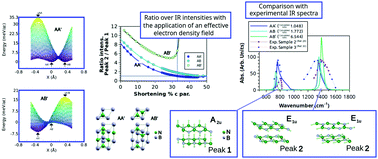Lattice dynamics in the conformational environment of multilayered hexagonal boron nitride (h-BN) results in peculiar infrared optical responses†
Abstract
Stacking mismatches in hexagonal boron nitride (h-BN) nanostructures affect their photonic, mechanical, and thermal properties. To access information about the stacked configuration of layered ensembles, highly sophisticated techniques like X-ray photoemission spectroscopy or electron microscopy are necessary. Here, instead, by taking advantage of the geometrical and chemical nature of h-BN, we show how simple structural models, based on shortened interplanar distances, can produce effective charge densities. Accounting these in the non-analytical part of the lattice dynamical description makes it possible to access information about the composition of differently stacked variants in experimental samples characterized by infrared spectroscopy. The results are obtained by density functional theory and confirmed by various functionals and pseudopotential approximations. Even though the method is shown using h-BN, the conclusions are more general and show how effective dielectric models can be considered as valuable theoretical pathways for the vibrational structure of any layered material.



 Please wait while we load your content...
Please wait while we load your content...